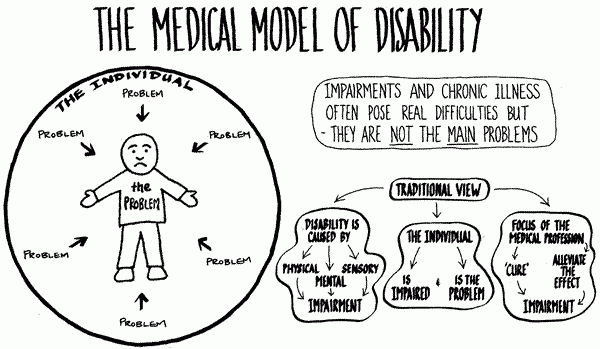This is the first in a series of blogs which will enable us to delve deeper into the world of disabilities. The intent is to access information from diverse sources to expand our own understanding through a variety of lenses. A larger and more informed picture would possibly lead to more awareness and meaningful engagement.
The word ‘disability’ tends to invoke very specific images in the mind, of individuals unable to fit into the ‘normal’, and thus the response varies from pity to indifference to often a misplaced sense of philanthropy. The latter viewpoint often manifests itself in either the ‘charity’ or ‘curative’ belief rather than empathetic rationality which would enable a life of equitable dignity for the ‘disabled’. This piece of writing is aimed at introducing various models or school of thoughts in understanding perceptions of disability to seek an approach that empowers systemically.
The Tragedy/Charity Model:
A prima facie, sympathetic statement is actually the slow poison which is fed to most persons with disability. The representation of a disabled person as poor, unfortunate, ailing and dependent is the charity model which makes sympathetic do-gooders as champions of the cause of the needful population without any recognition to the knowledge, needs, wants and potential to be independent of persons with disability. Persons with disability are perceived as victims of their impairment, they need to be pitied, they are portrayed as unable to perform a daily task and need to be looked after, and the help is coming from the belief of doing a service to the population. Their disability becomes their identity.
The Medical Model:
The lens of perceiving disability as a physical problem which needed to be cured by medical attention marks the ideology the medical model of disability. They tend to believe that disability is abnormal and one should strive to make these abnormal people normal. There is no effort made to change the surrounding or the society around the disabled person to make it more accessible for the person but the disabled person has to be changed. This approach is more focused on the functionality of an Individual, be it physical, sensory or mental, and advocates for a more clinical approach to disability.
SOURCE: http://environmentallychallenged.org/blog/individual-model-of-disability/
The Social Model:
The social model of disability deals with the attitude, environment and institutional organisation of society. It talks about the discrimination, inaccessibility and exclusion faced by persons with disability on a day to day basis living in society. The discrimination and barriers raised are firstly, attitudinal which is in backdrop of some religious and cultural practices which in general ignore the participation of person with disability in societal chores and have very low expectation which leads to isolation and segregation from the masses; secondly, environmental which is the organisation of the society and spaces such as public buildings, hospitals, malls, transport, restaurants, shops etc. The inaccessibility makes the person disabled and this can be overcome if the places are made accessible which will be enabling; thirdly, institutional discrimination which legally excludes disabled persons from accessing their rights and abstain from regular schools, have a family. The sanctions are put in by the government which gives little or no right to the persons with disability and are treated as second-grade citizens. The classic example of institutional discrimination would be Nazi party ruled Germany. The social model of disability advocates of making the society enabling, the problem identified by them is not with the persons with disability but with the disabling society which has failed to take an integrated approach to make it accessible and enabling.
SOURCE: http://environmentallychallenged.org/blog/social-model-of-disability/
The Rights Based Model:
The shift from charity approach to rights-based approach is majorly due to the adoption of United Nation Convention on the Rights of a Person with Disability in the year 2006 and enforceable from the year 2008, marking it the latest model to approach disability. It gives disability a socio-political connotation and advocates for entitlement on equal footing to economic, political, civil, social and cultural rights to the persons with disability. It routes through empowering and mainstreaming to achieve the aim of equal rights and opportunities for persons with disability. It identifies the right to live independently and reaffirms that persons with disability are part of humanity and human diversity and any discrimination of any ground are infringing their human rights. The rights-based approach relies on the principle of non-discrimination, equality of opportunity, gender equality, Inclusion and participation, accessibility, human diversity, Independence and autonomy of persons with disability. Therefore, a rights-based approach not only focuses on integration but inclusion.
Finding the approach:
The intent of every model was the welfare of persons with disability. However, with passing time the intent faded away in the lack of recognition of the need and their right. The modern approach of inclusion than the benevolent charity model seems to be the order of the hour. However, for effectuating this model, the general population has to make the shift in their mind, in their thought process and their approach and recognise the existence of rights of persons with disability.
References
- Lang, Dr R. (2001, January). Retrieved July 3, 2017, from London’s Global University: http://www.ucl.ac.uk/lc-ccr/lccstaff/raymond-lang/DEVELOPMMENT_AND_CRITIQUE_OF_THE_SOCIAL_MODEL_OF_D.pdf
- Worm, I. (2012, December). Article: Downloads. Retrieved July 3, 2017, from CBM website: https://www.cbm.org/article/downloads/54741/A_human_rights-based_approach_to_disability_in_development.pdf
- (2011). World Report on Disability
- The Charity Model. (2012, January 1). Retrieved July 2, 2017, from Stillmyrevolution: https://stillmyrevolution.org/2012/01/01/the-charity-model/
- The Four Models. (n.d.). Retrieved July 2, 2017, from Handicap International: http://www.making-prsp-inclusive.org/en/6-disability/61-what-is-disability/611-the-four-models.html



